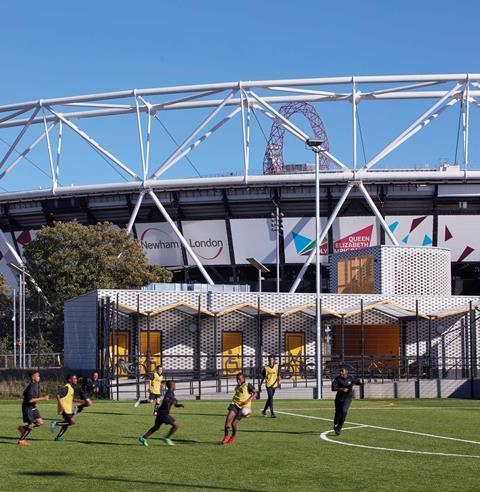Read about the winner and shortlisted entries for this year’s Small project of the Year Award
Winner: The Pavilion, Bobby Moore Academy

Entered by Penoyre & Prasad
Located at the heart of the Queen Elizabeth Olympic Park on the site of the former Games in east London, the Pavillion at the Bobby Moore Academy is a single-storey building incorporating male and female changing rooms for the school’s multi-use games area – a space that is also used by the community out of hours. A brick garden wall wraps around the small site to form an urban edge to the exterior while opening up with a more colourful facade on the interior.


Runners-up
Carshalton Boys Sports College English Learning Zone
Entered by Fraser Brown Mackenna
Challenged with a constrained site and limited funding, Fraser Brown Mackenna created a highly flexible contemporary learning environment complete with eight new classrooms and dedicated storage space, set over two storeys. A wide central corridor acts as a breakout area for study groups and improves the flow of students between lessons, while floor-to-ceiling windows and rooflights were used to maximise natural light in the design of the building.
Neuron Pod
Entered by aLL Design
Conceived by aLL Design director the late Will Alsop, based on a neuron cell, this freestanding structure sits in the publicly accessible mews at Queen Mary University of London’s Blizard Institute. It is a dedicated event space for the institute’s Centre of the Cell education programme. With the raw steel shell constructed offsite, Neuron Pod is clad with fibre optics and elevated on three legs. The weathering steel facade is still in the process of developing its rusted surface.
Shaftesbury Hall
Entered by Mulroy Architects
The project, built by T&B Contractors on the site of an old chapel, provides a helpline facility for the North London Samaritans and a local community hall. After an eight-year wait to gain planning approval and winning a grant from the Heritage Lottery Fund, Mulroy Architects rebuilt a local hub in the exact footprint of the old structure, recreating — rather than preserving — the derelict church as a functional, sustainable community space.
St Thomas’s Apartment
Entered by Allford Hall Monaghan Morris
In this project to convert the disused belfry of a listed south-east London church into a residential unit, AHMM balanced the heritage requirements and character of the existing structure against the necessities of modern living. Its solution made use of exposed brickwork and a timber roof structure in creating a seven-storey, one-bedroom home, complete with the original spiral staircase, smart underfloor heating and energy-efficient LED lighting.
Stephen Hawking School
Entered by Tower Hamlets Architecture Team
This redevelopment of an existing vacant special educational needs school in east London’s Tower Hamlets involved completely gutting the interior, widening existing access and creating a new front extension and therapy pool. Large skylights were installed in the reception area to provide a bright and welcoming entrance, while a palette of materials was compiled working with the school to ensure the children would be comfortable in their surroundings. A roof terrace was also created to provide a relaxing space for teachers to unwind from their daily challenges at the school.
University for the Creative Arts Film & Media Centre
Entered by Pascall+Watson
Situated at the University for the Creative Arts’ Farnham, Surrey, campus, the new centre’s facilities include a black-box film studio, a 260-seat lecture theatre and an acoustically sealed recording studio. The scheme is designed to offer future flexibility, with a lecture hall that can be easily transformed into rehearsal and exhibition spaces. The centre, which was constructed by Jerram Falkus, uses natural ventilation with external louvres that act as shading devices, while polycarbonate panels and subtle lighting techniques bring an elegance to the building.
Wildernesse Mews
Entered by Morris+Company
Architect Morris+Company was briefed to create a flagship development for the care and support of older people as part of a contemporary housing scheme within a retirement community in Kent. Located within the Wildernesse conservation area, the architecture of the site has been derived from both the surrounding nature and the former stable yard, situated near the grade II-listed Wildernesse House close to Sevenoaks. At the heart of the plans for this residential scheme for older people lies the idea of safe and secure environments that promote healthy living and wellbeing.
Topics
Big names scoop prizes at the 2019 Building Awards

Mace, Alinea and ISG among the winners
- 1
- 2
- 3
- 4
- 5
- 6
- 7
- 8
- 9
- 10
- 11
- 12
- 13
- 14
- 15
- 16
- 17
- 18
- 19
- 20
- 21
 Currently
reading
Currently
reading
Building Awards 2019: Small Project of the Year (up to £5m)
- 23






































































No comments yet